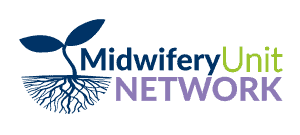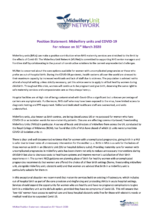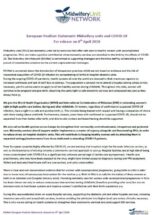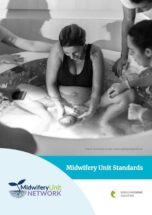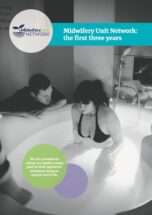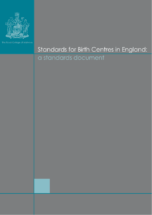
Policy
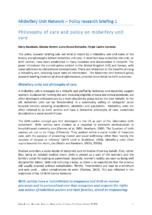
This policy research briefing sets out what is meant by a midwifery unit and some of the history and philosophy behind midwifery unit care. It describes how midwifery-led units have been established in...
| Size | 180.06 KB |
| Downloaded | 4212 times |
| Last Updated | 10th October 2018 |
Download | |
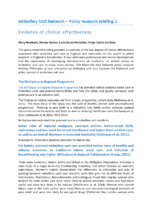
This policy research briefing provides a summary of the clinical effectiveness associated with midwifery unit care in England, and comments on the extent to which research in England is transferable to...
| Size | 152.37 KB |
| Downloaded | 107 times |
| Last Updated | 10th October 2018 |
Download | |
Better Births: Improving outcomes of maternity services in England. A Five Year Forward View for maternity care. NHS England 2016
The report of a major consultation and review of maternity services in England and Wales, published in 2016.
NCT Policy Briefing: midwife-led units, community maternity units and birth centres, NCT 2011
NCT is a UK charity providing information and support to parents. This document discusses the social model of care, the environment and facilities available in birth centres, and who can book care in a birth centre. It summarises latest outcomes evidence associated with both freestanding and alongside midwifery units, including costs and cost effectiveness.

Guidance & Toolkits
Midwifery Led Units – A Best Practice Resource by London Maternity Clinical Network
February 2021
Two of the core principles of good maternity care that are intrinsically intertwined are choice and safety. This resource developed by the Maternity Clinical Network, many of our leading midwives, and with the generous support of service users in London, demonstrates these two principles working in harmony in the supporting of women’s choice of place of birth. Birthing Centres represent a very important part of midwifery and maternity care, offering a haven of peace and calm for women to meet their new babies and an opportunity for the skills of the midwife in supporting physiological birth to come to the fore. Increasing birth in midwifery led settings’ sets out how that vision can become and be sustained as a safe reality for service users and midwives together. We are deeply grateful to all the contributors to this important resource for London services as they continue in their journeys of transformation and quality improvement in maternity care.
Kate Brintworth , Regional Chief Midwife for London
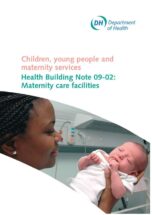
Summary: Practical guidance from the Department of Health (England) for those building maternity services, including midwifery units. ...
| Size | 3.44 MB |
| Downloaded | 1369 times |
| Last Updated | 14th November 2018 |
Download | |
Freestanding Midwifery Units: Local, high quality maternity care.
Busting the myths. Royal College of Midwives 2011
This document outlines the care offered by Freestanding Midwifery Units and answers many frequently asked questions about this type of service.
Midwifery and Human Rights: A Practitioner’s Guide, BIHR 2016
This Guide, produced by the British Institute of Human Rights, has been developed to support midwives to deliver maternity services that respect human rights by providing accessible information about human rights and how they are relevant in a maternity context. It specifically relates to UK Human Rights law and English health policies and services, but may be of use to those in other countries.
Increasing the number of births at home and in midwifery led units: A best practice toolkit. London Strategic Clinical Networks 2015
Intrapartum care for healthy women and babies. National Institute for Health and Care Excellence (NICE), 2014
The English National Institute for Health and Care Excellence guidelines on intrapartum care. Most recently updated in February 2017.

Quality Standards
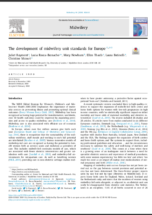
The new Midwifery Unit Standards were developed to bring to- gather the best available evidence related to service delivery. They identify key indicators which address dynamic factors influencing organistional...
| Size | 479.23 KB |
| Downloaded | 1398 times |
| Last Updated | 25th August 2020 |
Download | |
Quality Standard for Intrapartum Care, National Institute for Health and Care Excellence (NICE) 2015
This quality standard, produced by the English National Institute for Health and Care Excellence (NICE) describes high-quality care in priority areas. It covers the care of women and their babies during labour and immediately after the birth and includes women who go into labour at term, women at low risk of complications during labour and those who go on to develop complications.
The Birthplace In England Research Programme and related studies
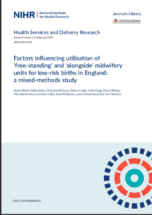
Midwifery-led units (MUs) are recommended for ‘low-risk’ births by the National Institute for Health and Care Excellence but according to the National Audit Office were not available in one-quarter...
| Size | 1.36 MB |
| Downloaded | 596 times |
| Last Updated | 24th August 2020 |
Download | |
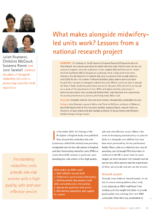
A summary, written for midwives, of the findings from the organisational case studies of alongside midwifery units. This short article outlines practical suggestions for what may help AMUs function effectively. ...
| Size | 188.92 KB |
| Downloaded | 103 times |
| Last Updated | 10th October 2018 |
Download | |
An analysis of media reporting on the closure of freestanding midwifery units in England
Despite clinical guidelines and policy promoting choice of place of birth, 14 Freestanding Midwifery Units were closed between 2008 and 2015, closures reported in the media as justified by low use and financial constraints. This paper uses an interpretative technique developed for policy analysis to explore the representation of these closures in 191 new articles to explore the public climate in which they occurred.
In writing this paper a team of researchers from University of Nottingham and City, University of London were involved.
Reference: Rayment, J., McCourt, C., Scanlon, M., Culley, L., Spiby, H., Bishop, S., de Lima, L.A. An analysis of media reporting on the closure of freestanding midwifery units in England. Women and Birth: https://doi.org/10.1016/j.wombi.2018.12.012
Barriers to women’s access to alongside midwifery units in England
Alongside midwifery units (AMUs) are managed by midwives and proximate to obstetric units (OUs), offering a home-like birth environment for women with straightforward pregnancies. They support physiological birth, with fast access to medical care if needed. AMUs have good perinatal outcomes and lower rates of interventions than OUs. In England, uptake remains lower than potential use, despite recent changes in policy to support their use. This article reports on experiences of access from a broader study that investigated AMU organisation and care.
Reference: Rayment, R., Rance, S., McCourt, C. & Sandall J. Barriers to women’s access to alongside midwifery units in England. Midwifery 77:78-85 : https://doi.org/10.1016/j.midw.2019.06.010
Organising safe and sustainable care in alongside midwifery units: Findings from an organisational ethnographic study
Alongside midwifery units (AMUs, also known as hospital or co-located birth centres) were identified as a novel hybrid organisational form in the Birthplace in England Research Programme. This follow-on study aimed to investigate how AMUs are organised, staffed and managed, the experiences of women, and maternity staff including those who work in AMUs and in adjacent obstetric units. This article focuses on study findings relating to the organisation and management of AMUs.
Reference: McCourt, C. Rance, S. Rayment, J., Sandall, J. 2018 Organising safe and sustainable care in alongside midwifery units: Findings from an organisational ethnographic study. Midwifery, 65 (2018) 26-34. https://doi.org/10.1016/j.midw.2018.06.023
Place of birth and concepts of wellbeing: an analysis from two ethnographic studies of midwifery units in England
This article is based on an analysis of a series of ethnographic case studies of midwifery units in England. Midwifery units are spaces that were developed to provide more home-like and less medically oriented care for birth that would support physiological processes of labour, women’s comfort and a positive experience of birth for women and their families. They are run by midwives, either on a hospital site alongside an obstetric unit (Alongside Midwifery Unit – AMU) or a freestanding unit away from an obstetric unit (Freestanding Midwifery Unit – FMU). Midwifery units have been designed and intended specifically as locations of wellbeing and although the meaning of the term is used very loosely in public discourse, this claim is supported by a large epidemiological study, which found that they provide safe care for babies while reducing the use of medical interventions and with better health outcomes for the women.
Reference: C, Rayment J, Rance S, Sandall J. (2016) Place of birth and concepts of wellbeing: an analysis from two ethnographic studies of midwifery units in England Anthropology in Action 23(3):17-29. https://doi.org/10.3167/aia.2016.230303
An ethnographic organisational study of alongside midwifery units
An ethnographic study focussing on the organisation, care and user experiences in four Alongside Midwifery Units in England.
Reference: McCourt, C. Rayment, J., Rance, S., Sandall, J. (2014) An ethnographic organisational study of alongside midwifery units: a follow-on study from the Birthplace in England programme. Health Services And Delivery Research 2014 VOL. 2 NO. 7. https://dx.doi.org/10.3310/hsdr02070
The Birthplace in England Research Programme. National Perinatal Epidemiology Unit, 2012
The strongest evidence we have to date on the safety of different planned places of birth in England. The Birthplace cohort study compared the safety of births planned in four settings: home, freestanding midwifery units (FMUs), alongside midwifery units (AMUs) and obstetric units (OUs). The main findings relate to healthy women with straightforward pregnancies who meet the NICE intrapartum care guideline criteria for a ‘low risk’ birth.
Perinatal and maternal outcomes by planned place of birth for healthy women with low risk pregnancies: the Birthplace in England national prospective cohort study
This prospective cohort study compares perinatal outcomes, maternal outcomes, and interventions in labour by planned place of birth at the start of care in labour for women with low risk pregnancies.

Economic Evaluations
The economic costs of intrapartum care in Tower Hamlets
This study compares the economic costs of intrapartum maternity care in an inner city area for ‘low risk’ women opting to give birth in a freestanding midwifery unit compared with those who chose birth in hospital.
Reference: Schroeder L, Patel N, Keeler M, Rocca-Ihenacho L, McFarlane A (2017) ‘The economic costs of intrapartum care in Tower Hamlets: a comparison between the cost of birth in a freestanding midwifery unit and hospital for women at low risk of obstetric complications’. Midwifery, 45:28-35
Cost effectiveness of alternative planned places of birth in woman at low risk of complications
A full evaluation of the cost effectiveness of planned birth at home, in a freestanding and alongside midwifery units, as compared with birth planned in an obstetric unit. This study drew on the data from the Birthplace in England Research Programme Cohort Study.
Reference: Schroeder, E.; S. Petrou; N. Patel; J. Hollowell; D. Puddicombe; M. Redshaw; P. Brocklehurst (2012) ‘Cost effectiveness of alternative planned places of birth in woman at low risk of complications: evidence from the Birthplace in England national prospective cohort study’ BMJ 344

Published Research
General
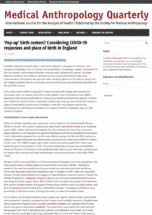
This thought-provoking article challenges the inconsistent use and closure of midwifery-led services throughout the pandemic and questions whether England got this right. Reference: Yuill C, McCourt C...
| Size | 115.88 KB |
| Downloaded | 629 times |
| Last Updated | 23rd August 2020 |
Download | |
Birth centres: a social model for maternity care.
The first comprehensive published book on Birth Centres, this book discusses the issues surrounding birth centres in England using the Edgware Birth Centre as a case study, and birth centres across the world.
Reference: Kirkham M (2003) Birth centres: a social model for maternity care. Books for Midwives.
An ethnographic study of a freestanding midwifery unit in an English town.
Reference: Walsh D (2006) ‘Improving Maternity Services: the epidemiologically based needs assessment reviews, Vol 2: Small is Beautiful – lessons from a birth centre’. CRC Press
Service Users
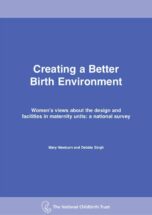
Summary: A survey of 2000 British women on their experiences of birthing in the UK maternity services, with a focus on environment and facilities. ...
| Size | 242.43 KB |
| Downloaded | 3351 times |
| Last Updated | 14th November 2018 |
Download | |
Making evidence about risks and benefits accessible to parents
This short article gives practical suggestions to practitioners on supporting women to make decisions about place of birth.
Reference: Coxon, K. (2012) ‘Making evidence about risks and benefits accessible to parents’ NCT Perspective. Issue 16
Survey of women’s experiences of care in a new freestanding midwifery unit in an inner city area of London
This article compares women’s choices and experiences of maternity care before and after the opening of the Barkantine Birth Centre, a freestanding midwifery unit in an inner city area of London.
Reference: McFarlane, A. J. et al. (2014) ‘Survey of women’s experiences of care in a new freestanding midwifery unit in an inner city area of London, England – 1: Methods and women’s overall ratings of care’ Midwifery 30 (9): 998-1008
Birthplace choices: what are the information needs of women when choosing where to give birth in England?
A qualitative study of women’s decision-making around place of birth. This research focussed on how and from whom women received information that helped them to make choices about where to have their babies.
Reference: Hinton, L., Dumelow, C., Rowe, R. and Hollowell, J. (2018) ‘Birthplace choices: what are the information needs of women when choosing where to give birth in England? A qualitative study using online and face to face focus groups’ BMC Pregnancy and Childbirth 18 (12)
Staffing, Workforce, Skills & Training
The efficient use of the maternity workforce and the implications for safety and quality in maternity care
A report on a study exploring the relationships between staffing models and clinical outcomes in English maternity services.
Reference: Sandall et al (2014) ‘The efficient use of the maternity workforce and the implications for safety and quality in maternity care: a population-based, cross-sectional study’. Health Services & Delivery Research. Vol 2 Issue 38.

Conference Presentations
Dr Lucia Rocca-Ihenacho, MUNet CEO, presents “Midwifery Unit Network: Spreading the Knowledge about Optimal Birth” at the inaugural International Maternity and Expo Awards, Nov 2019, London.

Equipment
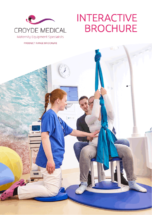
Croyde Medical is a Maternity Equipment Specialist based in Oxfordshire, England. They supply maternity specific equipment to the NHS, private organizations and Birth Centres all over the world. ...
| Size | 5.84 MB |
| Downloaded | 893 times |
| Last Updated | 5th November 2020 |
Download | |
Conferences – Icon made by Icon Pond from www.flaticon.com is licensed by CC 3.0 BY
Published research – Icon made by Freepik from www.flaticon.com is licensed by CC 3.0 BY
